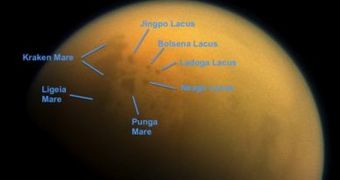A team of investigators at the University of Idaho in Moscow recently used data provided by the NASA Cassini spacecraft to highlight the presence of small waves on the liquid methane and ethane lakes on the surface of Titan, Saturn's largest moon. The existence of such waves has been proposed long ago, but never observed in practice.
The discovery was made possible by a good observations angle, from which Cassini was able to observe solar reflections on the surface of these lakes and seas. This enabled a team led by planetary scientist Jason Barnes to identify the first tentative evidences of extraterrestrial liquid ripples.
The team is the first to admit that additional data is needed to confirm the discovery. If subsequent works prove the new study correct, then this would be the first time ocean waves are discovered on another celestial body besides Earth, Nature News reports. Barnes says that Cassini was able to detect signs of potential waves in both 2012 and 2013.
Observations were conducted over one of the most prominent hydrocarbon seas on the Saturnine moon called Punga Mare. This is the third largest body of liquid methane and ethane on the moon and is located in the north polar region of Titan. It is larger than Lake Victoria, measuring an estimated 380 kilometers (236 miles) across.
Barnes said during a presentation held on March 17 at the Lunar and Planetary Science Conference that the waves Cassini saw are probably no taller than 2 centimeters (0.78 inches), adding that they are the only things to disturb the otherwise perfectly flat surface of Titan's seas and lakes.
It is entirely possible that studies conducted over the next few years will reveal additional hints of waves on the Saturnine moon. Titan is currently emerging from winter and heading towards spring. As winds pick up, more and more waves may develop on its seas, and Cassini will be there to see them.
“Titan may be beginning to stir. Oceanography is no longer just an Earth science,” comments planetary scientist Ralph Lorenz, who is based at the Johns Hopkins University's Applied Physics Laboratory in Laurel, Maryland. The finding comes shortly after Cassini celebrated its 100th flyby of the moon.
The probe was launched into space aboard a Titan IV delivery system from Space Launch Complex 40 at the Cape Canaveral Air Force Station in Florida, on October 15, 1997. The spacecraft achieved orbital insertion around Saturn on July 1, 2004, and it has been studying the gas giant, its ring system, and its moons ever since.
Its primary mission was supposed to last just 4 years and end in 2008, but several extensions have seen to it that Cassini remains operational around Saturn until at least 2017. NASA reserves the option to extend the flight even further, depending on spacecraft health and fuel availability.

 14 DAY TRIAL //
14 DAY TRIAL //